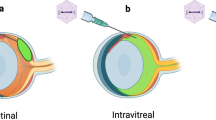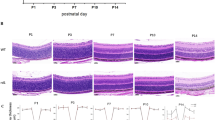Abstract
Intraocular delivery of a variety of neurotrophic factors has been widely investigated as a potential treatment for retinal dystrophy (RD). The most commonly studied factor, ciliary neurotrophic factor (CNTF), has been shown to preserve retinal morphology and to promote cell survival in a variety of models of RD. In order to evaluate CNTF as a potential treatment for RD, we used the Prph2Rd2/Rd2 mouse. CNTF was expressed intraocularly using AAV-mediated gene delivery either by itself or, in a second treatment group, combined with AAV-mediated gene replacement therapy of peripherin2, which we have previously shown to improve photoreceptor structure and function. We confirmed in both groups of animals that CNTF reduces the loss of photoreceptor cells. Visual function, however, as assessed over a time course by electroretinography (ERG), was significantly reduced compared with untreated controls. Furthermore, CNTF gene expression negated the effects on function of gene replacement therapy. In order to test whether this deleterious effect is only seen when degenerating retina is treated, we recorded ERGs from wild-type mice following intraocular injection of AAV expressing CNTF. Here a marked deleterious effect was noted, in which the b-wave amplitude was reduced by at least 50%. Our results demonstrate that intraocular CNTF gene delivery may have a deleterious effect on the retina and caution against its application in clinical trials.
This is a preview of subscription content, access via your institution
Access options
Subscribe to this journal
Receive 12 print issues and online access
$259.00 per year
only $21.58 per issue
Buy this article
- Purchase on Springer Link
- Instant access to full article PDF
Prices may be subject to local taxes which are calculated during checkout



Similar content being viewed by others
References
Bessant DA, Ali RR, Bhattacharya SS . Molecular genetics and prospects for therapy of the inherited retinal dystrophies. Curr Opin Genet Dev 2001; 11: 307–316.
Ali RR et al. Restoration of photoreceptor ultrastructure and function in retinal degeneration slow mice by gene therapy. Nat Genet 2000; 25: 306–310.
Acland GM et al. Gene therapy restores vision in a canine model of childhood blindness. Nat Genet 2001; 28: 92–95.
LaVail MM et al. Multiple growth factors, cytokines, and neurotrophins rescue photoreceptors from the damaging effects of constant light. Proc Natl Acad Sci USA 1992; 89: 11249–11253.
LaVail MM et al. Protection of mouse photoreceptors by survival factors in retinal degenerations. Invest Ophthalmol Vis Sci 1998; 39: 592–602.
McGee Sanftner LH, Abel H, Hauswirth WW, Flannery JG . Glial cell line derived neurotrophic factor delays photoreceptor degeneration in a transgenic rat model of retinitis pigmentosa. Mol Ther 2001; 4: 622–629.
Green ES et al. Two animal models of retinal degeneration are rescued by recombinant adeno-associated virus-mediated production of FGF-5 and FGF-18. Mol Ther 2001; 3: 507–515.
Chong NH et al. Repeated injections of a ciliary neurotrophic factor analogue leading to long-term photoreceptor survival in hereditary retinal degeneration. Invest Ophthalmol Vis Sci 1999; 40: 1298–1305.
Liang FQ et al. Long-term protection of retinal structure but not function using RAAV.CNTF in animal models of retinitis pigmentosa. Mol Ther 2001; 4: 461–472.
Liang FQ et al. AAV-mediated delivery of ciliary neurotrophic factor prolongs photoreceptor survival in the rhodopsin knockout mouse. Mol Ther 2001; 3: 241–248.
Cayouette M, Gravel C . Adenovirus-mediated gene transfer of ciliary neurotrophic factor can prevent photoreceptor degeneration in the retinal degeneration (rd) mouse. Hum Gene Ther 1997; 8: 423–430.
Cayouette M et al. Intraocular gene transfer of ciliary neurotrophic factor prevents death and increases responsiveness of rod photoreceptors in the retinal degeneration slow mouse. J Neurosci 1998; 18: 9282–9293.
Bok D et al. Effects of adeno-associated virus-vectored ciliary neurotrophic factor on retinal structure and function in mice with a P216L rds/peripherin mutation. Exp Eye Res 2002; 74: 719–735.
Sarra GM et al. Gene replacement therapy in the retinal degeneration slow (rds) mouse: the effect on retinal degeneration following partial transduction of the retina. Hum Mol Genet 2001; 10: 2353–2361.
Zhang X et al. High-titer recombinant adeno-associated virus production from replicating amplicons and herpes vectors deleted for glycoprotein H. Hum Gene Ther 1999; 10: 2527–2537.
Caffe AR, Soderpalm AK, Holmqvist I, van Veen T . A combination of CNTF and BDNF rescues rd photoreceptors but changes rod differentiation in the presence of RPE in retinal explants. Invest Ophthalmol Vis Sci 2001; 42: 275–282.
Wahlin KJ, Campochiaro PA, Zack DJ, Adler R . Neurotrophic factors cause activation of intracellular signaling pathways in Muller cells and other cells of the inner retina, but not photoreceptors. Invest Ophthalmol Vis Sci 2000; 41: 927–936.
Wahlin KJ, Adler R, Zack DJ, Campochiaro PA . Neurotrophic signaling in normal and degenerating rodent retinas. Exp Eye Res 2001; 73: 693–701.
Marc RE . Extreme neural remodeling in adult rodent photoreceptor degeneration models. In: 6th Annual Vision Research Conference; 3 May 2002, Fort Lauderdale; 2002, p O2.3.
Acknowledgements
FCS is a Marie Curie Fellow (EU). This work was supported by grants from The Sir Jules Thorne Charitable Trust and The Foundation Fighting Blindness.
Author information
Authors and Affiliations
Rights and permissions
About this article
Cite this article
Schlichtenbrede, F., MacNeil, A., Bainbridge, J. et al. Intraocular gene delivery of ciliary neurotrophic factor results in significant loss of retinal function in normal mice and in the Prph2Rd2/Rd2 model of retinal degeneration. Gene Ther 10, 523–527 (2003). https://doi.org/10.1038/sj.gt.3301929
Received:
Accepted:
Published:
Issue Date:
DOI: https://doi.org/10.1038/sj.gt.3301929
Keywords
This article is cited by
-
Ciliary neurotrophic factor-mediated neuroprotection involves enhanced glycolysis and anabolism in degenerating mouse retinas
Nature Communications (2022)
-
AAV9-Mediated Cardiac CNTF Overexpression Exacerbated Adverse Cardiac Remodeling in Streptozotocin-Induced Type 1 Diabetic Models
Cardiovascular Toxicology (2022)
-
Impacts of ciliary neurotrophic factor on the retinal transcriptome in a mouse model of photoreceptor degeneration
Scientific Reports (2020)
-
CNTF Gene Therapy Confers Lifelong Neuroprotection in a Mouse Model of Human Retinitis Pigmentosa
Molecular Therapy (2015)
-
C1q enhances cone photoreceptor survival in a mouse model of autosomal recessive retinitis pigmentosa
European Journal of Human Genetics (2012)



